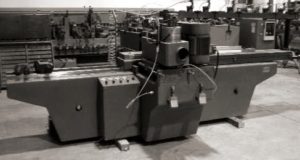TYPES OF SHAPERS
Shapers are classified under the following headings:
(1) According to the type of mechanism used for giving reciprocating motion to the ram
(a) Crank type
(b) Geared type
(c) Hydraulic type
(2) According to the type of design of the table:
(a) Standard shaper
(b) Universal shaper
(3) According to the position and travel of ram:
(a) Horizontal type
(b) Vertical type
(c) Traveling head type
(4) According to the type of cutting stroke:
(a) Push type
(b) Draw type.
A brief description these shapers is given below-
1. Crank Shaper
This is the most common type of shaper. It employs a crank mechanism to change circular motion of a large gear called “bull gear” incorporated in the machine to reciprocating motion of the ram. The bull gear receives power either from an individual motor or from an overhead line shaft if it is a belt-driven shaper.
2. Geared Shaper
Geared shaper uses rack and pinion arrangement to obtain reciprocating motion of the ram. Presently this type of shaper is not very widely used.
3. Hydraulic Shaper
In hydraulic shaper, reciprocating motion of the ram is obtained by hydraulic power. For generation of hydraulic power, oil under high pressure is pumped into the operating cylinder fitted with piston. The piston end is connected to the ram through piston rod. The high pressure oil causes the piston to reciprocate and this reciprocating motion is transferred to the ram of shaper. The important advantage of this type of shaper is that the cutting speed and force of the ram drive are constant from the very beginning to the end of the cut.
4. Standard Shaper
In standard shaper, the table has only two movements, horizontal and vertical, to give the feed.
5. Universal Shaper
A universal shaper is mostly used in tool room work. In this type of shaper, in addition to the horizontal and vertical movements, the table can be swiveled about an axis parallel to the ram ways, and the upper portion of the table can be tilted about a second horizontal axis perpendicular to the first axis.
6. Horizontal Shaper
In this type of shaper, the ram holding the tool reciprocates in a horizontal axis.
7. Vertical Shaper
In vertical shaper, the ram reciprocates in a vertical axis. These shapers are mainly used for machining keyways, slots or grooves, and internal surfaces.
8. Travelling Head Shaper
In this type of shaper, the ram while it reciprocates, also moves crosswise to give the required feed.
9. Push Type Shaper
This is the most general type of shaper used in common practice, in which the metal is removed when the ram moves away from the column, i.e. pushes the work.
10. Draw Type Shaper
In this type of shaper, the cutting of metal takes place when the ram moves towards the column of the machine, i.e. draws the work towards the machine. The tool is set in a reversed direction to that of a standard shaper.
Source A Textbook of Basic Manufacturing Processes and Workshop Technology by Rajender Singh.












Post Comment
You must be logged in to post a comment.